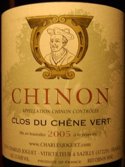|
Cabernet Franc Wine
Therefore, in most cases Cab Franc is just a bit part player. However, there are a few notable examples in which primarily Cabernet Franc wine is made to great effect. Some of these wines with a significant proportion of Cab Franc (or even exclusively Cab Franc) are amongst the very best in the world. In other words, this "lowly" cousin of Cabernet Sauvignon is capable, in the right hands and grown in the right terroir, of greatness. Read on below to learn more about the wines, where they are from and what they taste like. Where Is Cabernet Franc Wine Made?While Cabernet Franc is an integral, if minor, part in many Bordeaux blends, it has been transplanted to most major wine producing regions around the world. In particular, most areas that produce any Bordeaux type blends, including Cabernet Sauvignon and/or Merlot-based wines, plant at least some small proportion of Cab Fran to use in their blends.However, there are a few places on the planet where Cabernet Franc really shines and does not have to play second fiddle to any other grape. One is in the right bank of Bordeaux, in villages like Pomerol and St. Emilion. While most wines are predominantly Merlot, Cabernet Franc often plays an important part of the blend. In one notable example, Cabernet Franc is the leading actor, making up the majority of the blend in one of the most famous, expensive and glorious wines made anywhere. Château Cheval-Blanc, although the name sounds like it would be a white wine (blanc means white in French), is a famous red wine from the St. Emilion region on the right bank of Bordeaux. "Cheval-Blanc" means "white horse", the white has nothing to do with the color of the wine. The vineyards at this famous chateau are approximately 75% Cabernet Franc. The Cabernet Franc wine is made primarily from Cab Franc blended with Merlot. While the exact percentages in the final wine vary somewhat from year to year, Cabernet Franc is usually 60% or more of the blend. This wine is considered one of the best in the world and is highly sought after by collectors. In great vintages, it is arguably the best expression of Cabernet Franc wine in the world. Although Cheval-Blanc is the most famous Cabernet Franc wine on the planet, some purists would argue that the real home of the grape variety and where it is most suited to the terroir is in the Loire Valley of France. Often called Breton locally, the grape is planted in many appellations along the Loire and in some make up the large majority of the blend. In particular, Chinon, Bourgueil and Samur-Champigny are all capable of making outstanding reds based largely on Cabernet Franc. In particular, if you want a "lesson" in great Cabernet Franc, check out the wines of producers like Joguet, Baudry, Breton and Rougeard. And best of all, most of them are still relatively inexpensive. In some other areas such as in California some producers have experimented with Cabernet Franc varietal wines that are largely or solely Cab Franc. These can vary in quality quite a bit, some being light and vegetal, others being rich and complex, comparing favorably with the producers Cabernet Sauvignons or Merlots. What Styles of Wine Does Cabernet Franc Produce and What Do They Taste Like?Cabernet Franc has a bit of a messy reputation. Many people will tell you that Cabernet Franc alone is lighter and weaker than Cabernet Sauvignon and that they have weird vegetal aromas, sometimes described as bell pepper, herbs or green beans. For the most part, these are based on experience with lesser wines where the Cabernet Franc did not ripen fully in a terroir suited to the grape. Well made Cab Franc can certainly have a slight herbal and peppery complexity to it, but if ripe it is not overpowering or off-putting. In addition, while it does generally produce wines with less tannic structure and power than its cousin, the best Cabernet Franc wine can have considerable power, depth, body and complexity.For example, Cheval Blanc is a very full-bodied wine that can age for decades. The 1947 is legendary and is considered by many to be the best wine ever made. While the younger vines and lesser cuvées of Joguet and Baudry wines from Chinon and Bourgueil can be more simple and fruity, the more serious single vineyard wines, such as Joguet's Chene Vert (pictured above) and Dioterie, can be long-lived, complex and dark. While they may have a bit more peppery freshness than an equivalent Bordeaux or other Cabernet Sauvignon-based wine, this is not a criticism, they are just different. The Loire wines tend to be a bit more traditional, with less new oak aging, than the Bordeaux counterparts. They tend to be a bit more wild, sauvage, with ample expression of their underlying terroir. This is a generalization of course. And it does not mean they are lesser wines. In fact, some are every bit as refined and elegant, just with a different personality. Some Famous Examples: Chateau Cheval-Blanc from St. Emilion in Bordeaux Single-vineyard Chinons of Joguet (Clos de la Dioterie, Clos du Chêne Vert, Les Varennes du Grand Clos) Single-vineyard Chinons of Baudry (Les Grezeaux, Clos Guillot and La Croix Boisée) Single-vineyard Samur-Champigny of Clos Rougeard (Les Poyeux and Le Bourg) Return to the Grape Varieties section.  |



 Cabernet Franc wine is a lesser known relative to Cabernet Sauvignon. The grape variety Cabernet Franc is closely related to Cab Sauvignon and in many respects is very similar. The grape originated and is one of the permitted varieties in
Cabernet Franc wine is a lesser known relative to Cabernet Sauvignon. The grape variety Cabernet Franc is closely related to Cab Sauvignon and in many respects is very similar. The grape originated and is one of the permitted varieties in 


